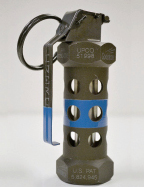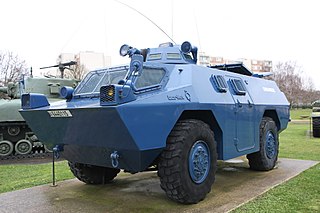This article has multiple issues. Please help improve it or discuss these issues on the talk page . (Learn how and when to remove these template messages)
|
The Alsetex 410 is a stun grenade manufactured by the French company Alsetex. [1] [ when? ]
This article has multiple issues. Please help improve it or discuss these issues on the talk page . (Learn how and when to remove these template messages)
|
The Alsetex 410 is a stun grenade manufactured by the French company Alsetex. [1] [ when? ]

An explosive device is a device that relies on the exothermic reaction of an explosive material to provide a violent release of energy.

The M203 is a single-shot 40 mm under-barrel grenade launcher designed to attach to a rifle. It uses the same rounds as the older stand-alone M79 break-action grenade launcher, which utilizes the high-low propulsion system to keep recoil forces low. Quite versatile and compatible with many rifle models, the M203 was originally designed for the U.S. M16 and its carbine variant, the M4. The launcher can also be mounted onto a C7, a Canadian version of the M16 rifle; however, this requires the prior removal of the bottom handguard.

A stun grenade, also known as a flash grenade, flashbang, thunderflash, or sound bomb, is a less-lethal explosive device used to temporarily disorient an enemy's senses. Upon detonation, a stun grenade produces a blinding flash of light and an extremely loud "bang". They are often used in close-quarters combat, door breaching, and riot control, typically to stun enemies or distract them.
A rifle grenade is a grenade that uses a rifle-based launcher to permit a longer effective range than would be possible if the grenade were thrown by hand.

The KS-23 is a Soviet shotgun. Because it uses a rifled barrel, it is officially designated by the Russian military as a carbine. KS stands for Karabin Spetsialniy, "Special Carbine". It is renowned for its large caliber, firing a 23 mm shotgun shell, equating to 6.278 gauge using the British and American standards of shotgun gauges and approximately 4 gauge using the current European standards, making it the largest-bore shotgun in modern use.

In current usage, a riot gun or less-lethal launcher is a type of firearm used to fire "non-lethal" or "less-lethal" ammunition for the purpose of suppressing riots or apprehending suspects with minimal harm or risk. Less-lethal launchers may be special purpose firearms designed for riot control use, or standard firearms, usually shotguns and grenade launchers, adapted for riot control use with appropriate ammunition. The ammunition is most commonly found in 12 gauge shotguns and 37mm or 40 mm grenade launchers.

The Type 11 70 mm infantry mortar, was a muzzle-loading, rifled bore infantry mortar used by the Japanese. The Type 11 designation was given to this gun as it was accepted in the 11th year of Emperor Taishō's reign (1922). It was first used in 1922 and was the first mortar to be introduced by the Imperial Japanese Army. The Type 11 was later replaced by the Type 92 battalion gun.

The United States Marine Corps Reconnaissance Battalions are the special operations reconnaissance assets of Marine Air-Ground Task Force that provide division-level ground and amphibious reconnaissance to the Ground Combat Element within the United States Marine Corps. Division reconnaissance teams are employed to observe and report on enemy activity and other information of military significance in close operations. The Military Occupational Specialty code for Reconnaissance Marine is 0321.

The M84 is the currently-issued stun grenade ("flashbang") of the United States Armed Forces and SWAT teams throughout the United States. Upon detonation, it emits an intensely loud "bang" of 170–180 decibels and a blinding flash of more than one million candela within 5 feet of initiation, sufficient to cause immediate flash blindness, deafness, tinnitus, and inner ear disturbance. Exposed personnel experience disorientation, confusion and loss of coordination and balance. While these effects are all intended to be temporary, there is risk of permanent injury. Consequently, the M84 is classified as a less-lethal weapon.

An airburst round is a type of tactical anti-personnel and anti-aircraft explosive ammunition, typically a shell or grenade, that detonates in midair, causing air burst effect fragment damage to enemy personnel or aircraft. In the latter case, airburst rounds are used in anti-aircraft or "zenith" cannon, known in military slang as FLAK or ack-ack.

The AG-C/EGLM is a single-shot 40 mm grenade launcher that attaches to assault rifles of various types. It is manufactured by Heckler and Koch and is derived from the AG36. EGLM stands for "Enhanced Grenade Launching Module". A stand-alone variant exists. The device attaches under the barrel. A separate sighting system is added to rifles fitted with the AG-C/EGLM, as the rifle's standard sights are not matched to the launcher. The AG-C/EGLM can fire high-explosive, smoke, illuminating, buckshot direct fire, CS gas, and training grenades.
The Messerschmitt Me 310 was a prototype German heavy fighter of World War II. It was a project to save the aerodynamically troubled Me 210.

The Berliet VXB-170 is a four-wheel armoured vehicle used primarily as an internal security vehicle. Developed and initially produced by Berliet until Berliet was merged with Saviem to form Renault Trucks, it lost to the Saviem VAB the competition to equip the French Army, even though it was cheaper than its competitor. Production stopped after fewer than 200 vehicles had been produced.

A grenade is an explosive weapon typically thrown by hand, but can also refer to a shell shot from the muzzle of a rifle or a grenade launcher. A modern hand grenade generally consists of an explosive charge ("filler"), a detonator mechanism, an internal striker to trigger the detonator, an arming safety secured by a transport safety. The user removes the transport safety before throwing, and once the grenade leaves the hand the arming safety gets released, allowing the striker to trigger a primer that ignites a fuze, which burns down to the detonator and explodes the main charge.
The 80.002 was a combined assault rifle and grenade launcher prototype based on the AK-74. The weapon was developed at TsNIITochMash by Yu.V. Minaev, V.I. Chelikin, and G.A. Yanov between 1975 and 1979. The main difference from the Kalashnikov is the presence of two adjacent barrels of 5.45 mm and 12.7 mm respectively. The thickness of the receiver was double that of an AK-74. The 80.002 was not accepted for service.

The 35 mm grenade is a type of grenade launcher ammunition of Chinese origin. The type consists of many high-velocity and low-velocity grenades with a caliber of 35 mm (1.38 in).